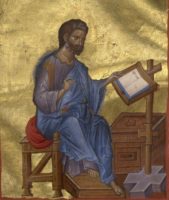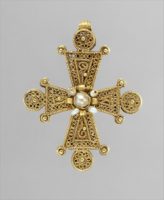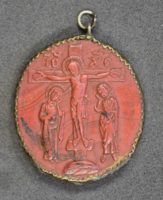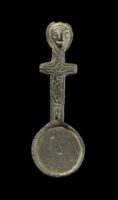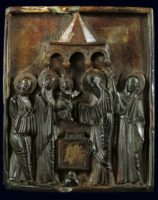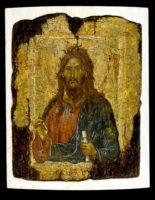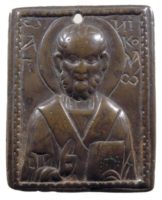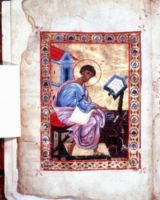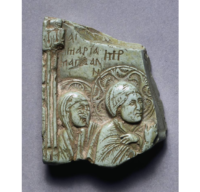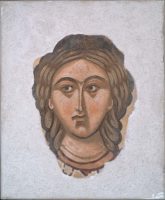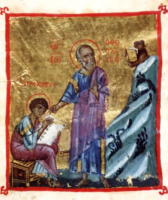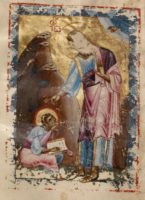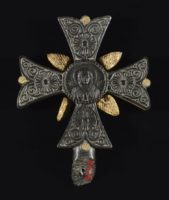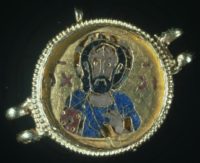Saint Mark. Period: Late Byzantine circa: late 13th century. Place: Constantinople (Place created) Dimensions: Leaf: 21 × 14.9 cm (8 1/4 × 5 7/8 in.). Museum Description: “Saint Mark pauses, quill in hand, as he writes his account of the life of Christ. This portrait of the saint as author introduces his Gospel in a Greek manuscript of the late 1200s. An inscription in red on the gold leaf background identifies the saint by name. ” The J. Paul Getty Museum at the Getty Center in Los Angeles houses European paintings, drawings, sculpture, illuminated manuscripts, decorative arts, and photography from its beginnings to the present, gathered internationally.
Cross with Pearls, Period: Late Byzantine, circa: 1200–1400. Materials: Gold and pearls. On view at The Met Fifth Avenue in Gallery 303. The Metropolitan Museum of Art (New York) is one of the world’s largest and finest art museums. Its collection includes more than two million works of art spanning five thousand years of world culture, from prehistory to the present and from every part of the globe. Public Hours: 10:30 a.m.–5:30 p.m. Open seven days a week.
The Last Supper, Period: Late Byzantine; circa: 13th century, Place: Nicaea, Modern Turkey. (created) Dimensions: Leaf: 20.6 × 14.9 cm (8 1/8 × 5 7/8 in.).
The J. Paul Getty Museum at the Getty Center in Los Angeles houses European paintings, drawings, sculpture, illuminated manuscripts, decorative arts, and photography from its beginnings to the present, gathered internationally.
Central Part of Triptych: Christ Pantocrator. Period: Late Byzantine; circa: Second half of 13th – early 14th century. Place: Byzantium, Macedon. Technique: tempera on panel. Dimensions: 29,3×21,8×3,2 cm. The collection of the State Hermitage includes over 3 million works of art and world culture artefacts. It contains paintings, graphic works, sculptures, works of applied art, archaeological artefacts and numismatic objects. The Hermitage is considered to have been founded in 1764, when Empress Catherine the Great acquired an impressive collection of works from the Berlin merchant Johann Ernst Gotzkowsky. The museum celebrates the anniversary of its founding each year on 7 December, St. Catherine’s Day. Opening Hours: Tuesday, Thursday, Saturday, Sunday: 10.30-18.00 Wednesday, Friday: 10.30-21.00 Closed: Monday.
Glass Cameo, Period: Late Byzantine; circa: 13th century A.D. Brick-red, opaque; on the front, the Crucifixion with, the Virgin at left, St John at right. Set in a metal frame. Diameter: 51 millimetres. British Museum is closed 24, 25 and 26 December and 1 January, but is open every other day of the year. Fast facts about the British Museum: Founded: 1753, Collection size: 8 million objects, Oldest object in the collection: Stone chopping tool (nearly 2 million years old).
Veil Embroidered with Gold Thread. Period: Late Byzantine; circa: end of the 13th or beginning of the 14th c. A liturgical article used for covering sacred vessels on an altar. It depicts Jesus in a portrayal of the Communion of the Apostles, symbolic of the sacrament of Holy Communion. One of the rare extant Byzantine embroideries. Made in: Constantinople. Dimensions: 0.52×0.65 m.
Copper alloy counterpoise coin balance; in the form of a rectangular beam with transverse bar, Late Byzantine (13-14 thc.)
Small steatite icon of the Presentation of Christ in the Temple , in high relief. Period: Late Byzantine; circa: 14th c. Dimensions: 0.11×0.09 m.
Icon with St John the Baptist, Icon painted in egg tempera with gold leaf on a wood panel surfaced with gesso and linen; the panel has a raised border. Period: Late Byzantine, 1300 (circa), Made in: Constantinople (Modern Istanbul, Turkey). Dimensions: Height: 251 millimetresWidth: 202 millimetres. British Museum is closed 24, 25 and 26 December and 1 January, but is open every other day of the year. Fast facts about the British Museum: Founded: 1753, Collection size: 8 million objects, Oldest object in the collection: Stone chopping tool (nearly 2 million years old).
Small icon of St Nicholas. Period: Late Byzantine; circa: First half of 13th century. Materials: bronze. The Benaki Museum of Greek Culture is housed in one of the most beautiful neoclassical-style buildings in Athens, near the National Garden and the Hellenic Parliament. It was converted into a museum in order to shelter the collections of Antonis Benakis and was donated to the Greek nation by himself and his three sisters, Alexandra, Penelope and Argine. Following its most recent refurbishment (1989–2000), the building houses a unique exhibition on Greek culture arranged diachronically from prehistory to the 20th century.
Christ Pantocrator with Donators, Period: Late Byzantine, circa: Circa 1363. Technique: tempera on panel. Dimensions: 106 x 79 x 2,8 cm. The collection of the State Hermitage includes over 3 million works of art and world culture artefacts. It contains paintings, graphic works, sculptures, works of applied art, archaeological artefacts and numismatic objects. The Hermitage is considered to have been founded in 1764, when Empress Catherine the Great acquired an impressive collection of works from the Berlin merchant Johann Ernst Gotzkowsky. The museum celebrates the anniversary of its founding each year on 7 December, St. Catherine’s Day. Opening Hours: Tuesday, Thursday, Saturday, Sunday: 10.30-18.00 Wednesday, Friday: 10.30-21.00 Closed: Monday.
Gospels of Luke and John, Period:Middle Byzantine, circa: Late 12th-early 13th century A.D. The museum is open to the public Tuesday through Sunday, 11:30 a.m.–5:30 p.m., except for federal holidays.
Fragment of an Icon of the Crucifixion with Mary Magdalen and the Virgin Mary. Material: Steatite. Period: 14th century, Late Byzantine. The Cleveland Art Museum Hours: Tuesdays, Thursdays, Saturdays, Sundays 10:00 a.m.–5:00 p.m. Wednesdays, Fridays 10:00 a.m.–9:00 p.m. Closed Mondays.
Four Icons from a Pair of Doors (Panels), possibly part of a Polyptych: John the Theologian and Prochoros, the Baptism (Epiphany), Harrowing of Hell (Anastasis), and Saint Nicholas. Period: Late Byzantine, early 15th century, Made in Crete, Materials: Tempera and gold on wood. On view at The Met Fifth Avenue in Gallery 303. The Metropolitan Museum of Art (New York) is one of the world’s largest and finest art museums. Its collection includes more than two million works of art spanning five thousand years of world culture, from prehistory to the present and from every part of the globe. Public Hours: 10:30 a.m.–5:30 p.m. Open seven days a week.
Head of a Female Saint, Fresco transferred to panel, Period: Late Byzantine circa: 12th-14th centuries. The MFA is open 7 days a week. Monday and Tuesday 10 am–5 pm, Wednesday–Friday 10 am–10 pm, Saturday and Sunday 10 am–5 pm.
Manuscript Leaf, St. John and Prochoros, Period: Late Byzantine, 13th century. The museum is open to the public Tuesday through Sunday, 11:30 a.m.–5:30 p.m., except for federal holidays.
Saint John the Evangelist Dictating, Manuscript, Period: Late Byzantine; circa: 1200 to 1225. Place: Nicomedia (Modern Izmit, Turkey) Materials: Tempera colors and gold leaf on parchment. Dimensions: Leaf: 20.6 × 14.9 cm (8 1/8 × 5 7/8 in.) The J. Paul Getty Museum at the Getty Center in Los Angeles houses European paintings, drawings, sculpture, illuminated manuscripts, decorative arts, and photography from its beginnings to the present, gathered internationally.
Benediction Cross, Period: Late Byzantine, circa: 1200s-1400s. Materials: black schist, gold, silver. The Cleveland Art Museum Hours: Tuesdays, Thursdays, Saturdays, Sundays 10:00 a.m.–5:00 p.m. Wednesdays, Fridays 10:00 a.m.–9:00 p.m. Closed Mondays.
Relief plaque icon, depicting the Crucifixion with full-length figures of the Virgin on the left and St John on the right, Late Byzantine (13 thc). Materials: Steatite – Gold.
Double-sided circular jewellery attachment. Christ Pantokrator is depicted on one side and the Virgin Orans on the other side. Period: Late Byzantine; circa: early 12th century. Dimensions: 0,026 m. The Benaki Museum of Greek Culture is housed in one of the most beautiful neoclassical-style buildings in Athens, near the National Garden and the Hellenic Parliament. It was converted into a museum in order to shelter the collections of Antonis Benakis and was donated to the Greek nation by himself and his three sisters, Alexandra, Penelope and Argine. Following its most recent refurbishment (1989–2000), the building houses a unique exhibition on Greek culture arranged diachronically from prehistory to the 20th century.


